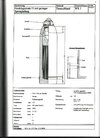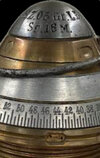Baltic_demo
Active Member
Hey , So , recently ive been surfing around german ww1 chemical rectangle , where Bruhmuller did his deeds)
According to artillery order , there where used 105mm howitzer blue cross shells …
By my experience… of finding hz05 gr fuzes when they used with Long howitzer grenade theyre greatly deformed , and rings usually are torn out by explosion products… when the full charge is appl ied and fully detonating..
ied and fully detonating..
But this fuze not only had all its rings , but also some of the main thread that is usually also being destroyed if the full charge of 2-1.8kg applied,moreover the base wasnt that really bent relatively to the HE shell fuze speciments.
I found it near shell krator , across this chemical rectangle 105 howitzer krators are rarely seen and usually theres 50 meters between them…
Other space is filled with fragmentation of 77mm green cross shells (yeah they differ and you can tell by the deformation and demage to the metal) , so , could it belong to the bluecross , and whats more important , the “M” letter thats near Spandau 1915 is it a month?
Experts and serious diggers , share your opinions please!
No previous history of h.e shell usage was recorded.
Of such type in that artillery sector.
According to artillery order , there where used 105mm howitzer blue cross shells …
By my experience… of finding hz05 gr fuzes when they used with Long howitzer grenade theyre greatly deformed , and rings usually are torn out by explosion products… when the full charge is appl
 ied and fully detonating..
ied and fully detonating..But this fuze not only had all its rings , but also some of the main thread that is usually also being destroyed if the full charge of 2-1.8kg applied,moreover the base wasnt that really bent relatively to the HE shell fuze speciments.
I found it near shell krator , across this chemical rectangle 105 howitzer krators are rarely seen and usually theres 50 meters between them…
Other space is filled with fragmentation of 77mm green cross shells (yeah they differ and you can tell by the deformation and demage to the metal) , so , could it belong to the bluecross , and whats more important , the “M” letter thats near Spandau 1915 is it a month?
Experts and serious diggers , share your opinions please!
No previous history of h.e shell usage was recorded.
Of such type in that artillery sector.









